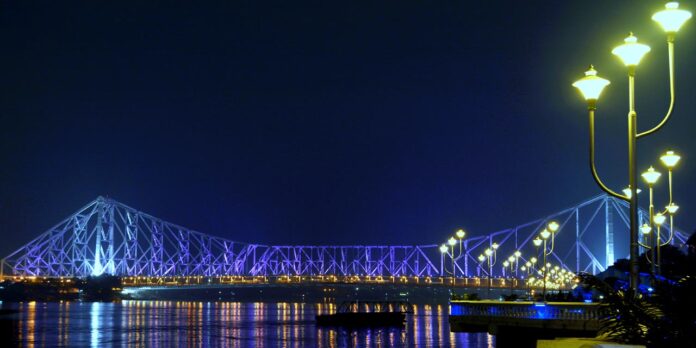75 Years of Howrah Bridge: The Howrah Bridge (Rabindra Setu) on the Ganga in the heart of Kolkata stands today as a unique example of architecture after 75 years. This bridge is not just a transportation route, it has become part of Kolkata’s history, culture and lifestyle. The bridge was opened to the public on 3 February 1943, shortly before India’s independence, and has since become one of Kolkata’s most important intersections.
History of construction and architecture
The construction of Howrah Bridge started in 1936, during the British rule. The cost of constructing the bridge was around 25 crore rupees, which was a huge amount in those days. Its architectural style was the cantilever bridge, which was considered one of the largest cantilever bridges in the world at the time. This bridge is 1500 feet long and 71 feet wide, connecting Kolkata and Howrah on the two banks of river Ganges. It is made entirely of iron and steel, and around 26,500 tons of steel were used in its construction, most of which was made by the then Tata.
The wonder of technology
The most remarkable aspect of Howrah Bridge is that no nut bolts were used in its construction. Instead, the entire bridge is constructed using a special technology called riveting. Besides, the bridge has two huge pillars below it, which are firmly placed in the water of Ganges, for stability and balance. The bridge is so strong that almost one lakh vehicles and several lakh pedestrians pass over it every year, yet it stands without any damage.
Economic importance
The Howrah Bridge is not only a means of transportation between Kolkata and Howrah, but is also considered an important bridge for the economy of the eastern region of India. Millions of people travel over this bridge every day, which connects the commercial hub of Kolkata. It connects the center of Kolkata with the Howrah railway station, one of the major transport hubs in eastern India.
Cultural influence
Howrah Bridge has a deep connection with the lives of the people of Kolkata. It has become a symbol of Bengali culture, featuring in many poems, songs, films and literature. From Satyajit Ray’s “Rival” to many Bengali and Hindi movies, Howrah Bridge has been seen as a central location. Besides, it has become a symbol of Kolkata’s heritage, creating a link between the old and new generations of the city.
Challenges and maintenance
For 75 years, the Howrah Bridge has faced not only natural disasters, but also man-made challenges. Rising water levels of the Ganga, floods, and constant vehicular loads have affected the bridge’s stability. However, this bridge is still intact with regular maintenance and repairs. The Works Department of the Government of West Bengal and the Kolkata Port Trust regularly maintain the bridge, so that it remains the heart of the city for many more years.
Future plans
On the occasion of 75 years of Howrah Bridge, the State Government and the Kolkata Port Trust have taken up special plans for the maintenance and beautification of the bridge. New lighting and decoration system will enhance the beauty of the bridge. Besides, special initiatives have been taken to highlight the history and importance of the bridge for tourists, so that the new generation can appreciate the value of this architecture.
Conclusion
Howrah Bridge is not just a bridge but an integral part of Kolkata’s history, culture and economy. For 75 years this bridge has been with the people of Kolkata as its architectural glory, witness to history and cultural symbol. As long as Calcutta exists, the Howrah Bridge will stand on the Ganga with its jowls, floating in the Ganga’s current. It is a symbol not only of the past but also of the future, which will become more glorious with time.








[…] Read More: 75 years of Howrah Bridge: The Ganges floats in Kolkata’s historic bridge […]